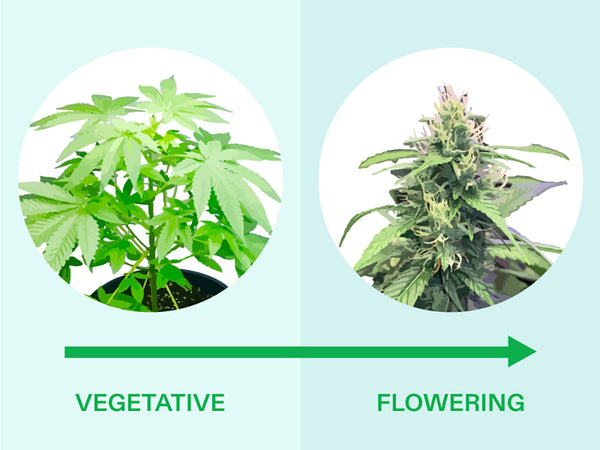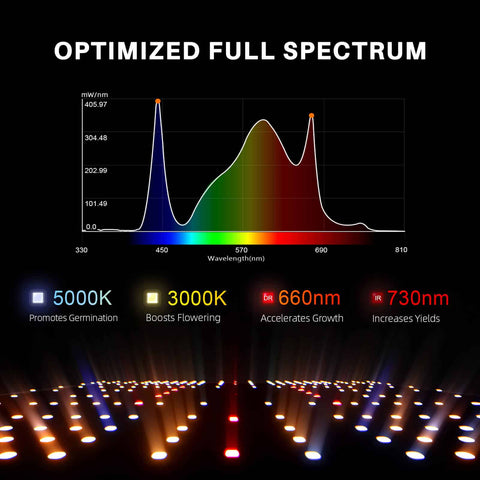
Growing cannabis indoors can be a fun and potentially lucrative hobby. However, it is essential to comprehend the cannabis plant's life cycle in order to cultivate a healthy plant, making knowledge in different light spectrums pivotal for any cannabis grower. Given that cannabis is a photosensitive plant, the schedule of your plant's exposure to light is crucial to its growth.
That is why purchasing high-quality, efficient LED lights for cannabis cultivation is crucial. Full-spectrum grow lights is crucial for cultivating a healthy, high-yield cannabis plant. However, it’s not enough. Because you will not be able to take full benefit of your grow light spectrum if you do not understand how different wavelengths of light affect your cannabis based on their growth cycle stage. Therefore, knowing how to adjust the light intensity, color, and frequency for each of its growth stages is crucial.
Understanding the Light Spectrum

Cannabis, like all plants, relies on light for photosynthesis – the process of converting light energy into the fuel it needs to grow, with the light color playing a significant role in this process. Understanding how different wavelengths of light influence your plants is critical if you want to maximize their health and yield.
- Visible Light - What We See: The light spectrum visible to our eyes is called Photosynthetically Active Radiation (PAR). Within PAR, different colors have specific impacts on your cannabis plants.
- Blue Light (400-500nm) - The Vegetative Powerhouse: Think of blue light as the "leaf and stem builder." It tells your cannabis plants to grow bushy with strong foliage, helping them develop a solid foundation for flowering.
- Red Light (600-700nm) - Flowering Fuel: Red light is the key driver of the flowering stage. It encourages bud development, leading to bigger, denser flowers and ultimately maximizing your yield.
We will go more into each light color in the next section.
How Do Different Colors of Light Affect the Growth of Cannabis?

Blue Light Wavelengths
The synthesis of chlorophyll, which helps plants absorb light, is significantly influenced by blue light. This light is best to use during vegetative growth, as it helps the plant produce more leaves and grow taller. It also encourages stem cells to produce longer stems, a beneficial effect that can be optimized by manipulating the red and far-red light spectrum in LED grow lights. However, blue light can also be detrimental to your plant, pointing to the need for a balanced color spectrum in LED grow lights.
The germination stage is when the plant starts to grow and develop roots, stems, leaves and flowers. When you use blue light during the germination stage, it can inhibit the growth of your plant. This is because different light spectrums play a crucial role in the growth and health of plants, especially in controlled environments like LED grow setups, where the effects of each light color under white light can be meticulously controlled for optimal growth. Blue light interferes with the phytochrome, which is the plant's natural response to light. When the phytochrome is disrupted by blue light, it doesn't respond correctly and the seed is unable to germinate.
Green Light Wavelengths
Green light has been demonstrated to have a positive effect on the growth of cannabis as it does not interrupt the plant's night cycle by mimicking moonlight. However, green light contributes minimally to the plant's growth and development. As compared to the absorption of blue or red light by chlorophyll, green wavelengths have been deemed to be less significant. Although not critical, green light still regulates plant architecture and photosynthesis.
Red Light Wavelengths
Red light, specifically 660nm, is the wavelength of light that most cannabis plants use to create their own energy, demonstrating the effects of each light color on plant growth. This means that the more red light a plant is exposed to, the faster it will grow. Red light is vital for the cannabis germination and flowering stages, influencing the effects of each light color on plant development. Adding red light encourages flowering and budding. When a cannabis plant is ready to bloom or bud, many growers increase the intensity of the red lights they were using.
However, much red light might lead your plants to stretch and grow tall, resulting in lesser yields and wobbly, elongated plants. To avoid this, grow indoors with a consistent light cycle of 16 hours of light and 8 hours of darkness per day.
Far-Red Light Wavelengths
Far-red light, with wavelengths around 730nm, described as far red, can be a valuable tool in influencing cannabis growth, especially in a grow room setup. It affects plant morphology, such as encouraging stem elongation, which can be beneficial in the early vegetative stages. Additionally, far-red light plays a role in flowering responses. Growers can manipulate the timing of flowering by strategically supplementing far-red light, potentially shortening flowering time and optimizing plant development for their desired yield.
UV Wavelengths
Did you know that UV is the reason why you need to wear your sunscreen when you’re outdoors? That's because overexposure to UV light can cause skin damage and lead to skin cancer, highlighting the importance of managing light treatments in the grow room carefully.
So why would you want your plants to be exposed to UV wavelengths? Well, UV light increases the terpene production in the cannabis plants, an important aspect of cannabis cultivation.. This is a good thing because terpenes are the compounds that give cannabis its flavor and fragrance.
By exposing your plants to UV light, you’ll be able to increase their production of terpenes. In higher concentrations, ultraviolet light can also harm plants, but the right light treatments can mitigate these effects. But with a small tolerable amount of UV light or UV rays, which is part of the light treatments, can improve the aroma, flavor, potency, and growth of cannabis plants.
From Vegetative to Flowering: What is the Best Light Spectrum for Each Stage?

Vegetative Stage
Cannabis plants have different light spectrum needs depending on their growth stage. During the vegetative stage, a focus on the blue light spectrum (400-500nm) is optimal. This blue light promotes strong stem development, compact growth, and the healthy foliage needed to power your plant through flowering. At 460nm, plants receive the signal to produce resilient, broad leaves. As your plants mature, their light requirements shift. To prepare them for flowering, it's wise to incorporate some red light throughout the later portion of the vegetative stage.
Flowering Stage
During the flowering stage, red light (620-740nm) becomes crucial. This focus on red light encourages your cannabis plants to channel their energy into developing large, resinous buds. Additionally, the right light intensity [mention PPFD briefly] is crucial during flowering to ensure plants can make full use of this spectrum.
Additional Considerations:
-
Light Intensity (PPFD): While having the right light spectrum is essential, the intensity of it also plays a crucial role too. Photosynthetic Photon Flux Density (PPFD) measures the amount of light that reaches your plants.Even with the perfect spectrum, insufficient PPFD will result in weak growth. Conversely, excessively high PPFD can cause light burn and damage your plants. Aim for PPFD levels recommended for your specific growth stage.
- Controlled Environment Factors: Environmental factors such as temperature, humidity, and CO2 levels interact with light spectra to influence plant growth. Maintaining optimal growing conditions is essential for maximizing the benefits of LED grow lights.
How Full Spectrum Mimic Natural Light for Bigger Yields, Healthier Plants, and Maximum Growth
Cannabis plants evolved to flourish under the full spectrum of natural sunlight. As we have discussed previously, this spectrum contains a wide range of wavelengths, each carrying a specific color and energy level. Plants use different wavelengths for essential processes like photosynthesis, growth, and flowering.
While indoor growers can achieve great results with traditional lighting, full-spectrum LED grow lights take things to the next level. These lights, equipped with advanced LED chips, closely replicate the ideal light source found in the visible spectrum. They emit a balanced blend of wavelengths, including blues for strong vegetative growth, reds for bountiful flowering, and other colors in between that contribute to overall plant health.
The Importance of a Balanced Spectrum: Why It Matters

While most growers understand the importance of blue and red light, relying solely on those wavelengths limits your plants' potential. Full-spectrum LEDs ensure your cannabis receives all the essential colors found in sunlight, maximizing its genetic potential. This balanced approach unlocks benefits like:
- Bigger Yields: Studies have shown that full-spectrum light can increase yields compared to traditional HPS or MH lights. By providing the optimal light recipe at every stage of growth, full-spectrum LEDs encourage robust development and denser, heavier flowers.
- Healthier Plants: Balanced light promotes a stronger immune system for your cannabis, helping it resist pests and diseases naturally. Plants grown under full-spectrum lighting, which includes the full visible spectrum, often exhibit stronger stems, thicker leaves, and overall better health, leading to increased cannabis yields.
- Maximum Growth: Without the "gaps" in the spectrum caused by relying on a few select colors, your cannabis plants receive the cues they need to thrive at every stage of their life cycle. This allows for maximum growth potential, ultimately translating to larger plants and a greater harvest, showcasing the impact of LED chip technology on maximizing cannabis yields.
Beyond the Science: The Practical Benefits of LEDs

While full-spectrum light offers a clear edge for your plants, LED technology itself comes with additional benefits:
-
Energy Efficiency: LEDs use significantly less electricity compared to traditional grow lights, translating to lower operating costs for you.
-
Cooler Operation: Traditional lights can generate a lot of heat, requiring additional climate control. LEDs run cooler, simplifying temperature management in your grow space.
-
Lifespan: LEDs boast a much longer lifespan than traditional bulbs, saving you money on replacements in the long run.
Choosing the Right Full-Spectrum LED Grow Light
Now that you understand the power of full-spectrum LEDs, you might be wondering how to choose the right one for your needs. Here are some key
factors to consider on selecting cannabis grow lights:
-
Grow Space Size: You need a light powerful enough to cover your entire grow area effectively.
-
Light Intensity: Look for a light with the appropriate PPFD (Photosynthetic Photon Flux Density) to deliver the desired light intensity for your plants.
-
Budget: LEDs range in price. Find the balance between quality and affordability that suits your needs.
Final Thoughts
It's clear that the grow light spectrum influences cannabis growth, but what isn't clear is how much of this influence is due to the actual spectrum of light and how much is due to the intensity of that light. However, the answer is that both matters.
The intensity of light can help you increase your yields, but only if you use it at the right time. If your cannabis plants receive too much light at any stage of their life cycle, they may grow tall and lanky or have a reduced yield, highlighting the necessity for using LED lights with a controlled light spectrum. Indeed, it's critical to understand how cannabis plants use light and how this can impact their growth.




